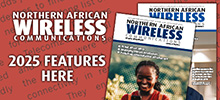10 February 2025

Maulik Shah, Co-Founder, Tragofone
The wireless ecosystem across Africa has grown exponentially in the last few years. The continent is ready to leverage the power of digital communication and the opportunities this revolution brings to both small and large businesses. There’s a rise in mobile adoption and investments in infrastructure. Here are some stats that present a better picture of growing infrastructure and mobile penetration:
- Tower installations across Africa are projected to grow from 199,092 in 2023 to 249,652 by 2028
- Mobile data consumption across Africa is predicted to quadruple by 2028
- 5G adoption is projected to reach 17% of the total mobile connections by 2030
- Morocco, in collaboration with Thales Alenia Space, is investing in a high-throughput satellite (VHTS) system
- Angola’s AngoSat-2 satellite connected hundreds of thousands of people through satellite broadband
Businesses are employing Voice over Internet Protocol (VoIP) alternatives like softphones over traditional phone lines. The progressive shift is bringing a new wave of seamless and smoother communication in Africa. In this growing wireless ecosystem, softphones are set to remodel the fundamental framework of business communication in the continent.
Softphones and the African business landscape
Softphones are software-based wireless communication solutions that convert any internet-connected device into a practical phone system, enabling high-quality voice and video calls over the Internet. Africa’s wireless ecosystem is still growing and faces communication challenges like connectivity inconsistency and varying infrastructure development. Softphones present a solution to tackle these challenges through reliable connectivity.
Communication hurdles
Despite the progress in wireless communication in Africa, there are still certain regions that struggle with quality and reliability issues. Some popular communication solutions in the continent have noticed rising complaints about dropped calls, jitter, and latency. Integration in local environments is another challenge that leads to missed business opportunities. Coupled with the high cost, these challenges become a barrier to the widespread adoption of digital services. Several users of a few acclaimed communication solutions have recently started showing interest in alternative platforms.
Softphone applications commit to tackling and resolving these pain points in Africa, offering seamless browser-to-browser communication, and features like push notifications which uphold call quality and seamless connection. Auto-provisioning is another feature that enables quick and hassle-free deployments, ensuring that critical business meetings aren’t cut short by technical glitches.
Empowering ISPs and PBX-based businesses
Across the African continent, Internet Service Providers (ISPs) who have their own PBX infrastructure are increasingly seeking tools that enhance their existing systems rather than replace them. Traditional PBX solutions are deeply ingrained in the telecommunications environment, and these ISPs are hot leads for advanced softphone platforms because they desire solutions that work with their current investments.
When ISPs leverage a softphone app that integrates effortlessly with PBX infrastructure, they can deliver a unified, consistent user experience — enabling their clients to use a single application for voice, video, messaging, and conferencing.
The rise of eSIM and the softphone opportunity
The demand for eSIM technology has been rising. eSIMs allow for remote provisioning of mobile network operator profiles without the need for physical SIM cards. This innovation prioritizes flexibility, mobility, and seamless user experiences.
With eSIM, users can switch providers or plans on the fly, and when combined with a softphone’s ability to operate on any internet-connected device, it creates a powerful synergy. Softphones can essentially run in tandem with these new mobile frameworks, enabling effortless global communication. By the time 5G connections and broader satellite coverage roll out across Africa — as hinted by various government and private sector initiatives — softphones will be well-positioned to capitalize on ultra-low latency and high bandwidth networks.
Driving digital transformation
Digital transformation initiatives across the continent are not solely focused on improved connectivity; they also emphasize training, skills development, and building the digital workforce of the future. Initiatives like Google.org’s grants for AI and cybersecurity skills training in sub-Saharan Africa are preparing the ground for a more tech-savvy generation of entrepreneurs, administrators, and knowledge workers.
Softphones, with their user-friendly interfaces and minimal hardware requirements, align perfectly with these new competencies. They enable a hybrid workforce, allowing employees and partners across Africa — whether in bustling urban centres or remote rural areas — to connect without friction. The continent’s mobile penetration rates continue to climb, and data centre capacity is projected to increase dramatically by 2030. This robust digital foundation supports a future where business communication tools are more vital than ever.
Future-proofing enterprises
As African economies diversify and integrate into global value chains, the communication demands placed on businesses will only intensify. Softphones stand at the nexus of several converging trends: the expansion of wireless infrastructure, the adoption of cloud-based services, the growth in remote and hybrid work, and the diversification of telecom technologies like 5G and satellite.
Moreover, softphones’ ability to evolve with the market is essential. Such solutions are built with modular, scalable architectures, enabling them to integrate emerging technologies – be it advanced AI-driven call analytics, virtual assistants, or tighter integrations with IoT and smart city solutions. In this way, businesses aren’t simply purchasing a one-time solution; they are engaging in a long-term strategy that flexes with market shifts.
The softphone advantage
In a continent where wireless communications are playing a pivotal role in economic growth and digital inclusion, softphones offer a cutting-edge, cost-effective, and reliable alternative to traditional telephony systems. By addressing concerns over call quality, reliability, and integration – and by empowering ISPs and PBX-reliant businesses to better serve their customers, softphones represent a critical step forward.
The rise of eSIM, the push towards AI-driven training, and the burgeoning opportunities presented by satellite and 5G networks all point to a future where seamless, high-quality communication is the norm. As African businesses navigate this complex, rapidly evolving environment, investing in advanced softphone technology stands out as a strategic move — one that ensures they remain connected, competitive, and ready to face the wireless world of tomorrow.






